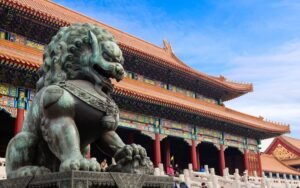Chinese folklore is a rich and vibrant part of Chinese culture, with a history that spans thousands of years. It encompasses a wide range of stories, legends, and myths that have been passed down through generations. These tales are not only entertaining, but they also serve as a way to teach moral lessons and convey important cultural values. Chinese folklore is deeply rooted in the beliefs and traditions of the Chinese people, and it continues to play a significant role in shaping their identity.
Table of Contents
ToggleKey Takeaways
- Chinese folklore is a rich cultural heritage with a variety of mythical creatures and legendary figures.
- The dragon is the most iconic creature in Chinese mythology, symbolizing power and good fortune.
- The phoenix represents rebirth and renewal, often associated with the emperor and empress.
- The qilin is a mythical creature of good fortune and prosperity, often depicted with a deer’s body and dragon’s head.
- The monkey king is a mischievous hero in Chinese folklore, known for his supernatural abilities and trickster nature.
The Dragon: The Most Iconic Creature in Chinese Mythology
The dragon is perhaps the most iconic creature in Chinese mythology. It is revered as a symbol of power, strength, and good fortune. In Chinese folklore, dragons are often depicted as benevolent creatures that bring rain and prosperity to the land. They are also associated with the emperor and are believed to be his divine protectors.
One famous dragon story is the legend of the Dragon Gate. According to this tale, there was once a carp that swam upstream against strong currents and leaped over a waterfall known as the Dragon Gate. As a reward for its perseverance, the carp transformed into a dragon. This story has become a symbol of perseverance and success in Chinese culture.
The Phoenix: A Symbol of Rebirth and Renewal
The phoenix is another important creature in Chinese mythology. It is often associated with the sun and is believed to represent rebirth and renewal. In Chinese folklore, the phoenix is depicted as a majestic bird with colorful plumage that brings good luck and prosperity.
One famous phoenix story is the legend of Fenghuang. According to this tale, the phoenix is said to appear only during times of peace and prosperity. It is believed to bring harmony and balance to the world. The phoenix is often depicted alongside the dragon, symbolizing the union of yin and yang, or male and female energies.
The Qilin: A Mythical Creature of Good Fortune and Prosperity
The qilin is a mythical creature in Chinese folklore that is often associated with good fortune and prosperity. It is depicted as a hybrid creature with the body of a deer, the tail of an ox, and the hooves of a horse. The qilin is believed to bring blessings and protect against evil spirits.
One famous qilin story is the legend of the Qilin Dance. According to this tale, a qilin appeared during the reign of Emperor Wu of Han and danced in front of the palace. The emperor took this as a sign of good fortune and prosperity for his kingdom. Since then, the Qilin Dance has become a popular tradition in Chinese culture, often performed during festive occasions.
The Monkey King: A Mischievous Hero in Chinese Folklore
The Monkey King, also known as Sun Wukong, is one of the most beloved characters in Chinese folklore. He is known for his mischievous nature, incredible strength, and magical abilities. The Monkey King is a central character in the epic tale “Journey to the West,” which tells the story of his adventures with a Buddhist monk named Xuanzang.
The Monkey King is often depicted as a trickster who outwits his enemies with his cleverness and wit. He possesses immense powers, such as the ability to transform into different animals and objects, and can even fly on clouds. Despite his mischievous nature, the Monkey King is also portrayed as a loyal and courageous hero who fights against evil and protects the innocent.
The White Snake: A Tale of Forbidden Love and Redemption
The White Snake is one of the most famous legends in Chinese folklore. It tells the story of a white snake spirit who falls in love with a human man named Xu Xian. Despite their forbidden love, the couple gets married and lives a happy life together. However, their love is tested when a Buddhist monk named Fahai discovers the true identity of the white snake and tries to separate them.
The White Snake legend is often seen as a tale of forbidden love and redemption. It explores themes of love, loyalty, and sacrifice. The story has been adapted into various forms of media, including operas, films, and television dramas, and continues to be a popular part of Chinese culture.
The Eight Immortals: Legendary Figures of Taoist Mythology
The Eight Immortals are legendary figures in Chinese folklore who are believed to have achieved immortality through their mastery of Taoist practices. Each immortal has their own unique abilities and characteristics. They are often depicted as wise and benevolent beings who help those in need and protect against evil spirits.
One famous story featuring the Eight Immortals is the legend of the Eight Immortals Crossing the Sea. According to this tale, the immortals were invited to attend a banquet on the island of Penglai. To reach the island, they had to cross a treacherous sea. Each immortal used their unique abilities to overcome the challenges and successfully reached the island.
The Jade Emperor: The Supreme Deity in Chinese Mythology
The Jade Emperor is the supreme deity in Chinese mythology. He is believed to be the ruler of heaven and earth and is often depicted as an elderly man with a long white beard. The Jade Emperor is associated with wisdom, justice, and divine power.
One famous story featuring the Jade Emperor is the legend of the Great Race. According to this tale, the Jade Emperor organized a race to determine the order of the Chinese zodiac animals. The rat won the race by hitching a ride on the back of the ox, while the cat was tricked by the rat and missed out on being one of the zodiac animals.
The Nian: A Ferocious Beast of Chinese Mythology
The Nian is a ferocious beast in Chinese mythology that is believed to appear on New Year’s Eve to terrorize villages and devour livestock and crops. It is often depicted as a lion-like creature with sharp teeth and a long horn on its head. The Nian is afraid of loud noises, bright lights, and the color red.
To ward off the Nian, the Chinese people developed various customs and traditions, such as setting off firecrackers, hanging red lanterns, and wearing red clothing. These practices are still observed today during Chinese New Year celebrations.
The Journey to the West: An Epic Tale of Adventure and Enlightenment
The Journey to the West is an epic tale in Chinese folklore that tells the story of a Buddhist monk named Xuanzang and his journey to obtain sacred Buddhist scriptures from India. Along the way, he is accompanied by the Monkey King, Pigsy, and Sandy, who help him overcome various obstacles and challenges.
The Journey to the West is not only an adventure story but also a spiritual journey. It explores themes of enlightenment, self-discovery, and the triumph of good over evil. The tale has been adapted into numerous forms of media, including television series, films, and comic books, and continues to be a beloved part of Chinese culture.
The Enduring Legacy of Chinese Folklore
Chinese folklore has a rich and enduring legacy that continues to shape Chinese culture today. These stories, legends, and myths are not only entertaining but also serve as a way to teach moral lessons and convey important cultural values. They reflect the beliefs, traditions, and aspirations of the Chinese people throughout history.
From the iconic dragon to the mischievous Monkey King, each character in Chinese folklore has its own unique symbolism and significance. These stories have been passed down through generations and continue to be celebrated and cherished by the Chinese people. They serve as a reminder of the rich cultural heritage of China and the enduring power of storytelling.
Contact our head teacher, Chen Huimin, at info@lcchineseschool.com if you want to learn Chinese or have additional questions about our Chinese programs.
Sign up for a free trial class here.
Learn about our Internship Program in China.
Get free Chinese learning resources.
Learn about China’s 2024 Offical Holiday Schedule







